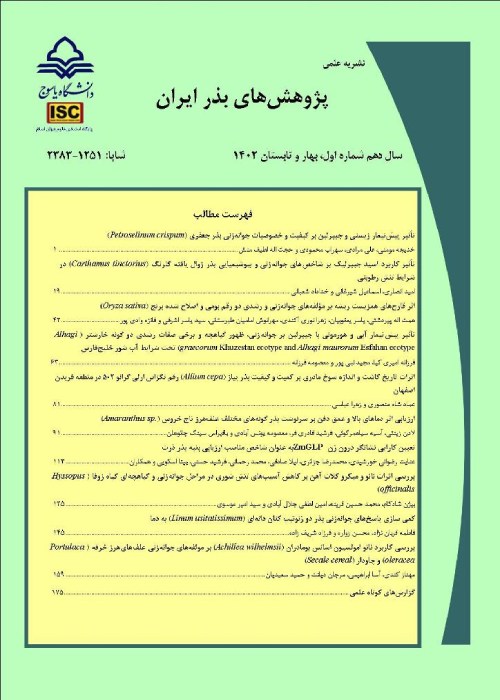Effect of Chitosan Nano Particle and Potassium Nitrate on Germination and Some Morpho-physiological Characteristics of Seedlings of Quinoa (Chenopodium quinoa)
Author(s):
Article Type:
Review Article (دارای رتبه معتبر)
Abstract:
Extended abstract
Introduction
Quinoa, with the scientific name (Chenopodium quinoa Willd), belongs to the Spencer family. Seeds vigor can be improved with a variety of seed priming methods. In this method, the seeds are soaked in water or various osmotic solutions and then dried to the original moisture. After priming treatment, seeds are stored and cultivated as untreated seeds. Potassium nitrate is the most frequently used chemical for the purpose of increasing seed germination and is recommended by the Society of Official Seed Specialists and the International Association of Seed Testing for germination experiments of many species. In recent years, the use of nanoscale materials has been of great interest to researchers. Chitin, one of the most abundant polysaccharides in nature, is a polymer chain of N-acetyl glucosamine and is associated with other proteins and other organic compounds, and numerous industrial, pharmaceutical and agricultural applications have been reported for it. The present study was carried out to investigate the effects of chitosan nanoparticles and potassium nitrate on some morphological characteristics, germination characteristics, chlorophyll content and relative humidity of quinoa plant.
Materials and Methods
In order to investigate the effect of pretreatment of quinoa seeds with chitosan nanoparticles and potassium nitrate solution on the early stages of germination, a factorial experiment was conducted in a completely randomized design with four replications in Seed Processing Laboratory, Faculty of Agricultural Sciences and Natural Resources, Shahed University, Tehran, Iran. Experimental treatments consisted of priming with chitosan nanoparticles in 4 levels (no primers, 0.01, 0.20 and 0.04% w / v) and potassium nitrate in 3 levels (no primers, 0.2 and 0.5% Weight percent) and hydroperime for 2 hours at 25° C. For each replicate of every treatment 100 seeds, using standard priming methods, were treated with the materials mentioned above and were dried in a petri dish on Watman paper No. 1 at 20 ± 1 ° C and relative humidity of 70% and 16 hours of daylight and 8 hours of darkness to make germination work. After that, germination percentage, root length, shoot length, germination coefficient, Allometric coefficient, relative water content, chlorophyll content a and b were measured, using standard methods.
Results
Seed treatment with 0.2% potassium nitrate solution increased germination by 9% and treatment with chitosan 0.01% increased germination by 14%, compared with the non-primer treatment. The priming treatment with a 0.5% solution of potassium nitrate and 0.01% chitosan increased germination by 36%, compared to the non-primer treatment. Potassium nitrate increased root length by 25% and shoot length by 10%. In addition, chitosan 0.01% increased the root length by 6%, and seeds with chitosan 0.02% and potassium nitrate 0.2% increased the root length by 32%. The effects of potassium nitrate, chitosan and their interaction on chlorophyll a and b were significant at 1% probability level. The highest levels of chlorophyll a were obtained in 0.02% chitosan and 0.2% potassium nitrate. This formulation increased the chlorophyll a content by 33%. The highest amount of chlorophyll b was obtained by applying 0.01% chitosan and 0.5% potassium nitrate.
Conclusion
The results of this study showed that treatment with 0.01% w/v chitosan and 0.5% w/v potassium nitrate resulted in the highest germination percentage, chlorophyll content a and b, relative water content, and stem length. Treatment with 0.02% chitosan and 0.2% potassium nitrate resulted in the highest allometric coefficient and root length.Highlights: Chitosan nano particle and potassium nitrate increase quinoa germination.
Chitosan nano particle and potassium nitrate increase the content of chlorophyll a and b
Keywords:
Language:
Persian
Published:
Iranian Journal of Seed Research, Volume:5 Issue: 1, 2018
Pages:
147 to 159
magiran.com/p1900029
دانلود و مطالعه متن این مقاله با یکی از روشهای زیر امکان پذیر است:
اشتراک شخصی
با عضویت و پرداخت آنلاین حق اشتراک یکساله به مبلغ 1,390,000ريال میتوانید 70 عنوان مطلب دانلود کنید!
اشتراک سازمانی
به کتابخانه دانشگاه یا محل کار خود پیشنهاد کنید تا اشتراک سازمانی این پایگاه را برای دسترسی نامحدود همه کاربران به متن مطالب تهیه نمایند!
توجه!
- حق عضویت دریافتی صرف حمایت از نشریات عضو و نگهداری، تکمیل و توسعه مگیران میشود.
- پرداخت حق اشتراک و دانلود مقالات اجازه بازنشر آن در سایر رسانههای چاپی و دیجیتال را به کاربر نمیدهد.
In order to view content subscription is required
Personal subscription
Subscribe magiran.com for 70 € euros via PayPal and download 70 articles during a year.
Organization subscription
Please contact us to subscribe your university or library for unlimited access!


